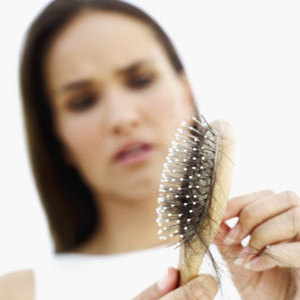Alopecia: get the facts
An estimated eight million women in the UK suffer from hair loss – and the emotional effects can be devastating. Here's all you need to know about the causes, treatments and where to get the advice and support you need...

What is alopecia?
Alopecia is the general medical term for hair loss. Women's hair gradually thins with age – particularly after the menopause when the drop in oestrogen levels also causes the growth cycle to shorten, meaning hairs tend to fall out earlier than they would once have done.
Aside from this natural age-related thinning, however, around 1.7 per cent of the UK population suffers from a more extreme – and potentially very distressing – form of hair loss known as alopecia areata. These are patches of baldness, usually around the size of a large coin, that may come and go. The condition normally occurs on the scalp, but can also affect other areas of the body.
In rare cases, people may go on to develop a more severe form of hair loss, such as alopecia totalis (no scalp hair) or alopecia universalis (no hair anywhere on the body).
What causes alopecia?
Alopecia areata is thought to be an autoimmune disease. The body's immune system mistakenly attacks groups of cells in the hair-producing follicles. The result? Existing hairs fall out and new ones are unable to grow. However, the follicles themselves aren't affected, so are still capable of producing new hair once the attack subsides.
So why does the attack happen in the first place? It's not known for certain – but possible triggers include viruses, infections or a reaction to medication. Some people appear more prone to the condition due to an inherited risk. Approximately one in five people with alopecia areata has a close relative with the condition.
It's also more common among people with other autoimmune conditions, such as diabetes, vitiligo or thyroid disease.
What about other forms of hair loss?
Scarring alopecia is caused by permanent damage to the hair follicles – usually as the result of another condition, such as discoid lupus (a mild form of lupus that affects the skin) or lichen planus (a non-infectious, itchy rash).
Telogen effluvium is a widespread temporary thinning of the hair, usually as a reaction to stress or medication. And anagen effluvium is hair loss caused by cancer treatments, most commonly chemotherapy. But not all chemotherapy leads to noticeable hair loss. And in the vast majority of cases, hair will grow back after treatment. To find out more, contact Cancer Research UK.
How is it treated?
In most cases of alopecia areata, the hair will eventually start to grow back – usually within a few months. And for that reason, the most commonly recommended course of action is 'watchful waiting'. If hair loss is patchy, rather than extensive, there's around an 80 per cent chance of complete regrowth within a year. As a general rule, the more severe the hair loss, and the longer the period without regrowth, the less likely it is to grow back.
There is no definitive treatment that can guarantee hair regrowth – and results vary greatly from person to person. Among the most commonly used are steroid creams and scalp applications, which are applied to the affected areas – usually twice daily – for a limited period of around three months. Alternatively, you may be prescribed corticosteroid injections, which can be used on the scalp and brows, and are among the most effective treatments for small patches of alopecia.
Other options include: steroid tablets, which can encourage regrowth when taken in large doses; Dithranol cream, a psoriasis treatment that also appears to stimulate hair growth; and ultraviolet light treatment, which is given two or three times a week in hospital. However, all of these methods involve possible side effects – and some may be uncomfortable and time-consuming - so it's important to discuss the pros and cons with your GP or dermatologist before going ahead. For more advice and information about treatments, contact Alopecia UK.
And what about the emotional effects?
Hair loss itself does not pose a risk to your physical health – but the psychological effects can be devastating. Losing your hair can make you feel as though you're losing part of your identity. It can lead to low self-confidence, low self-esteem and even depression. Your GP may recommend counselling. It may also help to join a support group and meet other people in the same situation. Find out more about groups near you – or get tips on how to start one – from Alopecia UK.
Many people prefer to wear a wig or headscarf while they wait for regrowth. Wigs are sometimes available on NHS prescription, although you may be required to contribute towards the cost. For more information, go to www.alopeciaonline.org.uk.
Could alternative therapies help?
Aromatherapy, acupuncture and massage have all been used to alleviate the emotional discomfort of alopecia – but, according to NHS guidelines, there's still not enough evidence to support their use as effective treatments for the hair loss itself.
Where can I find out more?
You can download a free information leaflet about alopecia areata from the British Association of Dermatologists.
You might also like...
Our complete guide to thinning hair and hair loss
20 ways to deal with thinning hair
Why do women suffer with hair loss and thinning hair?










